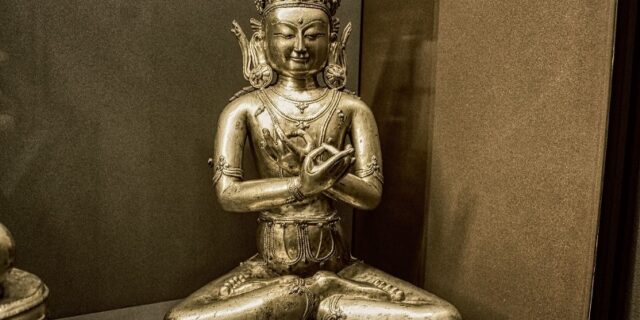
The phrase Brahmacharya (or Brahmacharyam) is a contraction of the two Indian Sanskrit words Brahma and Charya, meaning “one’s Self,” “the Divine,” or “God” (Brahma) and “way,” “conduct,” “follow,” or “occupation” (Charya).

Thus, literally, Brahmacharya means “following God” or “following one’s inner Self,” or “the way of God,” and so on, which refers to a spiritual practice. More specifically, it means adopting an attitude, a certain lifestyle of restraint, which covers guidelines on cleanliness, nonviolence, truthfulness, sexual continence, sexual abstinence, and celibacy, among some other topics.
As for sexual behavior, the idea behind Brahmacharya is that indulging in sex can be (or is) an obstacle to spiritual advancement, and that one needs to direct, cultivate, and use all one’s energies (including the powerful sexual energy contained in sexual fluids) for internal, spiritual purposes, and not for external, material drives or desires.
However, over the centuries in India, we find slightly different interpretations of the concept and practice of Brahmacharya, depending on the specific context wherein it’s used.
Monasteries
For instance, in Indian monastic traditions, Brahmacharya implies, among other things, the rejection of sex and marriage (including masturbation and sometimes even the thoughts about sex), which was and often still is considered a necessary prerequisite for one’s spiritual practice and progress as a monk.
Yoga
We also find the Brahmacharya directive in the classical Yoga Sutras of Patanjali (Eight Limbs Ashtanga Yoga). The guideline is already mentioned in “the first limb” (Yama or Abstinences) noting that Yogis should adhere to “a right conduct” to come to a fruitful meditation practice that leads to spiritual enlightenment, that is, Samadhi and Moksha.
In this context, it also refers to sexual restriction and control (for instance, avoiding sex before marriage), marital fidelity (if one is married, of course), and chastity. Do mind that it doesn’t mean that one cannot have sex.
Ashramas
In the Indian Ashramas system (the four stages of life), Brahmacharya refers to the student’s or adolescent’s life (the first Ashrama stage is from 0 up to about 25 years old), in which they should focus on learning, study, and righteous living, and as such also practice chastity and celibacy.
Tantra
In Tantric traditions, Brahmacharya rather means sexual continence, that is, applying conscious control during sexual intercourse without having an ejaculation by neither man nor woman. By doing so, one’s sexual energy is retained, as it were, which can and should be used for Kundalini Awakening and spiritual purposes.
















